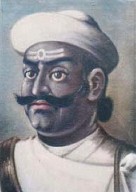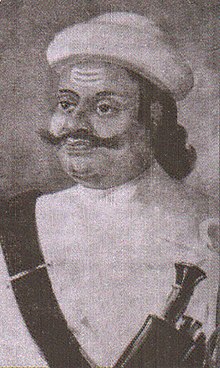User:Airkeeper/Pande dynasty
| Pande dynasty पाँडे वंश/पाँडे खलक | |
|---|---|
| Country | |
| Founded | 1801(as direct government) |
| Founder | Damodar Pande (as direct ruler) |
| Final ruler | Rana Jang Pande |
| Titles |
|
| Estate(s) | of Nepal |
| Deposition | 1804 (1st deposed) & 1840 (completely deposed) |

Pande dynasty or Pande aristocratic family (Nepali: पाँडे वंश/पाँडे खलक) is a Kshatriya Pande dynasty[1] that directly ruled Nepali administration affairs in the 19th century[2] as Mulkazi and Mukhtiyar (Prime Minister). This dynasty/family was one of the four noble family to be involved in active politics of Nepal together with Shah dynasty, Basnyat family and Thapa dynastys before rise of Rana dynasty.[1] The dynasty was established by descendents of nobleman Ganesh Pande of Gorkha Kingdom. Kalu Pande was a descendent of Ganesh Pande and the Kaji of Prithvi Narayan Shah.[3] He became prominent during the Unification of Nepal. Damodar Pande, third son of Kalu Pande became Mulkazi of Nepal and ruled the Nepalese administration directly in absence of King Rana Bahadur Shah establishing the Pande dynasty in the central government.[4]
This dynasty was connected to Thapa dynasty through daughter of Chief Kazi Ranajit Pande, Rana Kumari who was married to Nain Singh Thapa.[5] Pande dynasty and Thapa dynasty were the two rival Kshatriya families who contested for political power in the Royal court of Nepal.[6]
Background
[edit]
Ganesh Pande was the first Kaji (Prime Minister) of King Dravya Shah of Gorkha Kingdom.[7][8] The Pandes then was considered as Thar Ghar aristrocratic group who assisted the adminstration of Gorkha Kingdom.[9] Kaji Kalu Pande belonged to this family[3] became a war hero after he died at Battle of Kirtipur.[10]
Damodar Pande was appointed as one of the four Kajis by King Rana Bahadur Shah after imprisonment of Bahadur Shah of Nepal.[11] Damodar was most influential and dominant in the court faction irrespective of post of Chief Kazi (Mulkazi) being held by Kirtiman Singh Basnyat[11] leading Pandes at the front. After irrational behaviour of King Rana Bahadur Shah, situation of civil war arose where Damodar was the main opposition to the King.[12] After King left to India, Queen Regent Rajrajeshowri elected Damodar Pande as the Mul Kaji.[4]
Pande Palaces
[edit]
As Thapathali was abode of the Thapas, Lazimpat was abode of Pandes. Lazimpat Durbar was property of Kaji Bir Keshar Pande. At the time of the Kot massacre on 14 September 1846, Kaji Bir Keshar Pande was massacred there and lazimpat Durbar was occupied by Kaji Col.Tribikram Singh Thapa, maternal uncle of Rana rulers.[13]
Pande rulers and other members
[edit]| No. | Ruler | Image | Position | Years ruled |
|---|---|---|---|---|
| 1 | Damodar Pande |  |
Mulkazi (Prime Minister) and Commander-in-Chief | 1801 to 1804 A.D. |
| 2 | Ranajit Pande | MulKazi (PM) | 1804 A.D. | |
| 3 | Rana Jang Pande |  |
Mukhtiyar (Prime Minister) and Commander-in-Chief | 1837 to 1837 A.D. and 1839 to 1840 A.D. |
References
[edit]Notes
[edit]- ^ a b Joshi & Rose 1966, p. 23.
- ^ Joshi & Rose 1966, p. 25.
- ^ a b Singh 1997, p. 126.
- ^ a b Acharya 2012, p. 43.
- ^ JBR, PurushottamShamsher (1990). Shree Teen Haruko Tathya Britanta (in Nepali). Bhotahity, Kathmandu: Vidarthi Pustak Bhandar. ISBN 99933-39-91-1.
- ^ "Thapa and Pande family animosity". p. 26.
- ^ Regmi 1975, p. 30.
- ^ Wright 1877, p. 278.
- ^ Pradhan 2012, p. 8.
- ^ Wright, Daniel (1990). History of Nepal. New Delhi: Asian Educational Services. Retrieved 7 November 2012.
{{cite book}}: Cite has empty unknown parameter:|coauthors=(help) Page 227 - ^ a b Pradhan 2012, p. 12.
- ^ Acharya 2012, pp. 28–32.
- ^ JBR, PurushottamShamsher (2007). Ranakalin Pramukh Atihasik Darbarharu [Chief Historical Palaces of the Rana Era] (in Nepali). Vidarthi Pustak Bhandar. ISBN 978-9994611027. Retrieved 10 June 2017.
Sources
[edit]- Acharya, Baburam (2012), Acharya, Shri Krishna (ed.), Janaral Bhimsen Thapa : Yinko Utthan Tatha Pattan (in Nepali), Kathmandu: Education Book House, p. 228, ISBN 9789937241748
- Adhikari, Indra, Military and Democracy in Nepal, Routledge, ISBN 9781317589068
- Wright, Daniel (1877), History of Nepal
- Joshi, Bhuwan Lal; Rose, Leo E. (1966), Democratic Innovations in Nepal: A Case Study of Political Acculturation, University of California Press, p. 551
- Pradhan, Kumar L. (2012), Thapa Politics in Nepal: With Special Reference to Bhim Sen Thapa, 1806–1839, New Delhi: Concept Publishing Company, p. 278, ISBN 9788180698132
- Regmi, D.R. (1975), Modern Nepal
- Shaha, Rishikesh (1982), Essays in the Practice of Government in Nepal, Manohar, p. 44, OCLC 9302577
- Nepal, Gyanmani (2007), Nepal ko Mahabharat (in Nepali) (3rd ed.), Kathmandu: Sajha, p. 314, ISBN 9789993325857
- Hamal, Lakshman B. (1995), Military history of Nepal, Sharda Pustak Mandir
- Singh, Nagendra Kumar (1997), Nepal: Refugee to Ruler : a Militant Race of Nepal, APH Publishing Corporation, ISBN 9788170248477
